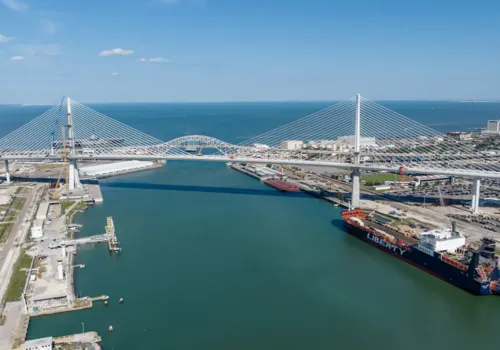
After years of delays and challenges, the $1.3 billion Harbor Bridge in Corpus Christi, Texas, officially opened Saturday, according to a city news release. Replacing the older bridge plagued by safety concerns and limited capacity, the new span is now the longest concrete segmental cable-stayed bridge in North America.

Constructed by FlatironDragados, the bridge stretches across the Corpus Christi Ship Channel with twin 538-foot towers, enabling the passage of taller ships and boosting the region’s cargo capabilities.
“The new Harbor Bridge solidifies Corpus Christi’s position as a global energy hub, home to the Port of Corpus Christi, the nation’s largest crude oil export gateway and the third largest in the world,” said Corpus Christi Mayor Paulette Guajardo.
Beyond its transportation function, the bridge includes features like a shared-use path for pedestrians and cyclists, LED lighting, xeriscape landscaping, and a new community plaza. It spans over 6 miles of bridge and connecting roads.
“With an expected service life of 170 years, this bridge will benefit the region for decades to come by providing faster commutes, safer travel and more economic opportunity,” said Texas Transportation Commissioner Alejandro “Alex” Meade III.
The original Harbor Bridge had design flaws including a steep grade, reverse curves, and no shoulders, all contributing to a high rate of accidents and poor pedestrian access. Its demolition was included in the scope of the new bridge project.

Originally slated for completion in 2020, the project encountered major delays, including cost disagreements, right-of-way issues, and COVID-19 disruptions. A 2023 crane fire also caused injuries near Whataburger Field. Work halted again in 2022 when Texas DOT issued a default notice over five critical design issues, pausing construction until FlatironDragados and engineer Arup addressed them. That dispute was resolved in October 2023.
As of now, only the southbound lanes have opened, with the northbound lanes expected to be operational by early July.
The completion of the Harbor Bridge marks a pivotal moment for the Corpus Christi region, aligning with broader infrastructure improvements aimed at supporting the port’s growth and attracting global trade. By accommodating Post-Panamax vessels, the bridge increases the port's competitiveness with other Gulf Coast facilities, a move expected to drive both logistics and manufacturing investments into the area.
Public engagement was a key feature of the project, with the new design reflecting community input on safety and accessibility. The shared-use path and community plaza aim to integrate the bridge more fully into the urban fabric of Corpus Christi, creating not just a vital transportation corridor, but also a civic landmark.
Environmental considerations were also factored into the project through the use of xeriscaping and modern drainage systems that reduce runoff and maintenance needs, in line with Texas’ growing emphasis on sustainable infrastructure.
Originally reported by Julie Strupp in Construction Dive.